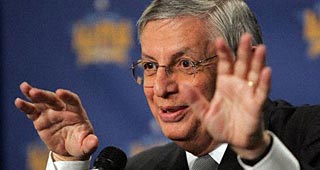The NBA released new sets of rules for the 2006-2007 season.
Calling Timeouts
2005-06 Rule:
The head coach may request a timeout (20-second or full) only if there is a suspension of play due to a player suffering an injury where bleeding occurs.
2006-07 Rule:
The head coach may request a timeout (20-second or full) at any time during a game as long as his team has possession of the ball or there is a suspension of play.
Substitutions
2005-06 Rule:
Free substitution is permitted only during 20-second timeouts called in the last two minutes of the fourth quarter and/or overtime period. During all other 20-second timeouts, the team calling the timeout may only substitute for one player, and if that team replaces a player, the opposing team may also replace one player.
2006-07 Rule:
Free substitution is permitted during all 20-second timeouts.
Clear-Path-To-The-Basket Fouls
A clear-path-to-the-basket foul is called if a personal foul occurs (1) when the ball and an offensive player are positioned between the tip-of-circle extended in the backcourt and the basket in the frontcourt, with no defender between the ball and the basket, (2) the possession originates in the backcourt, including throw-ins, and (3) the foul deprives the offensive team of an opportunity to score.
2005-06 Rule:
The team that is fouled is awarded one free throw attempt and the ball on the sideline.
2006-07 Rule:
The team that is fouled is awarded two free throw attempt and the ball on the sideline,
Active List Violations
Prior to the start of the game, a member of the officiating crew checks the Active Lists maintained by the official scorer against the players who are in uniform.
2005-06 Rule:
If a player not listed on a team?s Active List participates in game play, the officials, upon noticing or being made aware of the ineligible player, will disqualify the player at the first dead ball.
2006-07 Rule:
If a player not listed on a team?s Active List participates in game play, the officials, upon noticing or being made aware of the ineligible player, will disqualify the player at the first dead ball and the player?s team will be assessed a technical foul.
Free-Throw Procedures
2005-06 Rule:
Players occupying lane spaces during free-throw attempts are permitted to extend their bodies into adjoining lane spaces.
Players not occupying a lane space during a free- attempt must remain behind the three-point line until the ball is released by the free-throw shooter.
2006-7 Rule:
Players occupying lane spaces during free-throw attempts are prohibited from extending any part of their bodies into the space in front of an opponent until the ball is released by the free-throw shooter.
Players not occupying a lane space during a free- attempt must remain behind the three-point line and above the free-throw line extended until the ball is released by the free-throw shooter.
Flagrant Fouls ? Penalty 1
2005-06 Rule:
If a flagrant foul/penalty 1 is called and the fouled player is unable due to injury to shoot his free-throws, the opposing team?s coach selects a replacement free-throw shooter from among the players on the fouled player?s bench, and the injured player is not permitted to return to the game.
2006-07 Rule:
If a flagrant foul/penalty 1 is called and the fouled player is unable due to injury to shoot his free-throws, his team?s coach (not the opposing team?s coach) selects a replacement free-throw shooter from among players on the floor (not players on the bench) at the time of the foul, and the injured player is not permitted to return to the game.
Note: The rules for unsportsmanlike acts (elbow and punching fouls) and flagrant fouls/penalty 2 state the fouled player?s coach selects the replacement free-throw shooter from any eligible player on his team (whether on the playing floor or the bench) and the injured player is permitted to re-enter the game following the free-throw attempts. There is no change to this rule.


